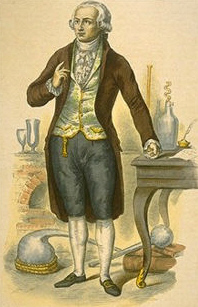|

Priestly in the late 1700’s was not only a scientist
but a defender of the American colonies to be free from
English rule |
Atmospheric sciences offered the “breakthrough” data that was
needed to determine how atoms work. Gases proved the easiest to
isolate and observe. In the 1700’s experiments by English
chemists Joseph Black (1728-1799) (discovered carbon
dioxide), Henry Cavendish (1731-1810) (discovered
hydrogen), and Joseph Priestly (1733-1804)(discovered
oxygen) isolated several gases and showed how they could be
produced from other substances. All of these early chemists
began to scientifically discuss the substances they were
isolating. Discussions lead to new experiments, which guided
the way to further discoveries.

Antoine-Laurent
de Lavoisier |
Antoine-Laurent de
Lavoisier
(1743-1794) was a French nobleman who wrote the first extensive
list of elements. He had identified 23 elements before his
untimely death. His experiments with oxygen allowed him to
isolate the gas, which started him to wonder about the nature of
the particles he was collecting. He was prominent not only in
chemistry but in finance, biology and economics. Unfortunately,
he was in the wrong place at the wrong time, and was beheaded
during the French Revolution.
John Dalton,
(1766–1844) a British teacher and
scientist wrote, A New System of Chemical Philosophy in
1808 which described “tiny” particles as the basis of all matter.
He revived the concept of atoms and proposed an atomic theory
based on facts and experimental observations in meteorology.
His work in meteorology started him to question about gases and
water and how they combined.
|